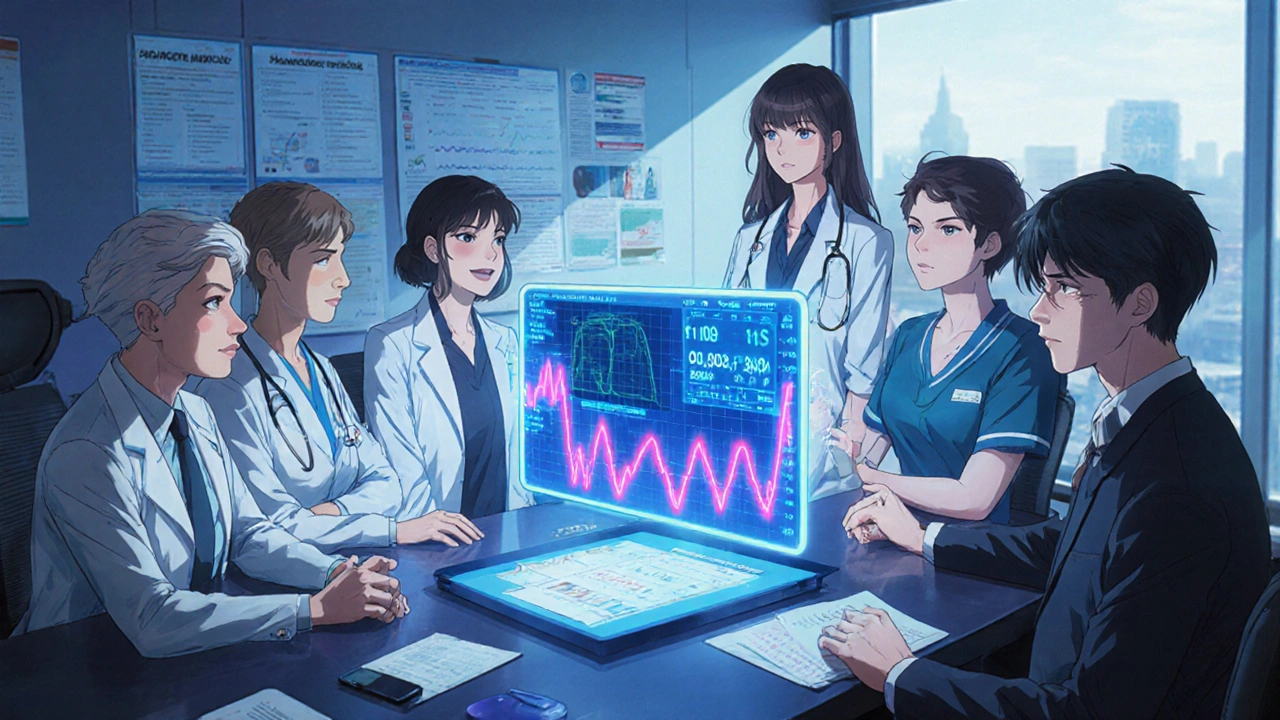Fluid Overload Risk Calculator
How This Works
Track your weight daily to detect fluid buildup early. The article states that gaining more than 1kg in 3 days or 2kg in 7 days may indicate fluid overload requiring medical attention.
Why It Matters
Early detection of fluid accumulation prevents hospitalization. Research shows 27% higher emergency admission rates among patients who miss regular follow-ups.
Results
When a heart’s left ventricle can’t pump efficiently, the whole circulatory system feels the strain. Left Ventricular Dysfunction is a condition where the left ventricle’s contractile ability is reduced, leading to lower ejection fraction and, if untreated, progressive heart failure. Patients often think the diagnosis is the end of the story, but the real work starts after the first appointment. Regular follow‑up is the lifeline that keeps symptoms in check, catches complications early, and improves long‑term survival.
What Happens If Follow‑Up Is Skipped?
Skipping routine visits isn’t just a missed calendar appointment; it removes a safety net that monitors several hidden risks:
- Silent decline in ejection fraction - The heart can worsen without obvious symptoms.
- Medication gaps - Doses may drift, new interactions appear, or side effects emerge.
- Arrhythmias - Irregular beats can develop unnoticed, raising sudden‑death risk.
- Fluid overload - Subtle weight gain or edema may go unnoticed until hospitalization is needed.
Research from the American Heart Association in 2023 showed that patients with left ventricular dysfunction who missed quarterly visits had a 27 % higher chance of emergency admission compared with those who attended regularly.
Core Goals of Follow‑Up Visits
Every check‑in should aim to hit three targets:
- Assess cardiac function - Use imaging or biomarkers to see if the ventricle is stabilizing or slipping.
- Optimize therapy - Tweak medications, consider device therapy, and ensure adherence.
- Educate and empower - Reinforce lifestyle changes, self‑monitoring, and when to call for help.
When these goals are met consistently, patient-reported quality of life scores improve by an average of 12 points on the Kansas City Cardiomyopathy Questionnaire, according to a 2024 multicenter trial.
How Often Should Patients Be Seen?
Follow‑up frequency isn’t one‑size‑fits‑all. It depends on severity, comorbidities, and treatment stage:
| Clinical Situation | Visit Interval | Key Focus |
|---|---|---|
| Newly diagnosed, EF < 35 % | Every 4-6 weeks for the first 3 months | Medication titration, symptom baseline |
| Stable on guideline‑directed therapy, EF 30‑40 % | Every 3-4 months | Echo review, biomarker trend |
| Post‑device implantation (ICD/CRT) | 1 month after implant, then every 6 months | Device checks, lead integrity |
| Advanced heart failure, NYHA III‑IV | Monthly or as needed | Advanced therapy eligibility, palliative planning |
These intervals are guidelines; clinicians may adjust based on a patient’s response, new symptoms, or lab values.

Tools that Make Follow‑Up Effective
Modern practice blends in‑office assessments with remote monitoring. Below are the most useful instruments:
- Echocardiography - Provides visual EF measurement, wall motion analysis, and valve assessment. A baseline echo followed by a repeat at 3‑month intervals catches early deterioration.
- BNP (B‑type natriuretic peptide) testing - Blood levels rise with increased ventricular pressure. Trending BNP every 1-2 months helps predict decompensation before dyspnea appears.
- Wearable cardiac monitors - Devices that record heart rate variability and detect arrhythmias in real time. Data can be uploaded to the clinic portal for rapid review.
- Cardiac Rehabilitation Programs - Structured exercise, nutrition counseling, and psychosocial support improve EF by up to 5 % in many patients.
- Medication Adherence Apps - Reminders, refill alerts, and side‑effect logs keep drug regimens on track.
Multidisciplinary Team: Who’s Involved?
Managing left ventricular dysfunction is a team sport. The core crew typically includes:
- Cardiologist - Leads therapy selection, device decisions, and high‑risk monitoring.
- Primary Care Physician - Coordinates overall health, vaccination, and comorbidity control (e.g., diabetes, hypertension).
- Nurse Practitioner or Physician Assistant - Handles routine vitals, education, and follow‑up calls.
- Pharmacist - Reviews medication interactions, dosing, and counseling on side effects.
- Physical Therapist - Designs safe exercise plans that boost cardiac output without overexertion.
When each member contributes consistently, the care bundle reduces hospital readmission by nearly one third, according to a 2022 meta‑analysis.
Patient Self‑Management Checklist
Even the best clinic schedule can’t replace daily vigilance. Encourage patients to tick off these items each week:
- Weigh yourself every morning; flag a rise of >2 kg in 3 days.
- Record blood pressure and heart rate; note any >10 % change.
- Take all prescribed meds on schedule; use a pillbox or app.
- Log any new symptoms - shortness of breath, palpitations, swelling.
- Review activity level - aim for 150 min of moderate exercise per week, unless limited by a physician.
- Prepare a concise summary for the next appointment: vitals, weight trend, medication changes, and questions.
Providing a printable version of this checklist during the first visit improves engagement by 22 %.

Common Pitfalls and How to Avoid Them
Even diligent patients stumble. Here are the top three roadblocks and practical fixes:
| Pitfall | Why It Happens | Solution |
|---|---|---|
| Missed appointments | Transportation or forgetfulness | Offer tele‑health slots and automated text reminders. |
| Medication non‑adherence | Side effects or complex regimens | Simplify dosing, involve pharmacists for counseling, use adherence apps. |
| Unrecognized fluid overload | Lack of daily weight tracking | Provide digital scales that sync to the clinic portal. |
When to Call the Doctor Right Away
Fast action can be lifesaving. Advise patients to seek urgent care if they notice any of the following:
- Sudden increase in shortness of breath at rest.
- Chest pain that radiates to the arm, jaw, or back.
- Rapid, irregular heartbeats that feel “fluttery” or “skipping.”
- Severe swelling in the legs or abdomen.
- Fainting or near‑fainting episodes.
These symptoms often signal worsening left ventricular dysfunction or an arrhythmic event that warrants immediate evaluation.
Frequently Asked Questions
How often should I get an echocardiogram?
For most stable patients, an echo every 6-12 months is enough. If you’re within the first three months of a new medication or after a hospitalization, your doctor may order one at 3‑month intervals to watch the ejection fraction closely.
Can wearable devices replace clinic visits?
Wearables are great for trend data-heart rate, rhythm, activity-but they can’t perform imaging or blood tests. Use them as a supplement, not a substitute, and always share the data with your care team.
What lifestyle changes matter most?
Low‑salt diet, regular moderate exercise, quitting smoking, and limiting alcohol dramatically lower the strain on the left ventricle. Pair these with weight management and blood pressure control for the biggest impact.
Is medication adjustment common during follow‑up?
Yes. Guideline‑directed therapy often starts low and is titrated upward. Your doctor may add ACE inhibitors, beta‑blockers, or newer agents like sacubitril/valsartan as you tolerate them.
When is an implantable cardioverter defibrillator (ICD) needed?
If your ejection fraction stays below 35 % despite optimal meds and you have a history of ventricular tachycardia, an ICD can prevent sudden cardiac death. The decision is made after a thorough risk assessment.

James Mali
October 18, 2025 AT 13:16Regular check‑ups are the quiet guardians of heart health 😊.
Margaret pope
November 1, 2025 AT 21:16A simple weekly weight check can catch fluid buildup before it becomes a problem.
Linda A
November 16, 2025 AT 06:16The heart, much like a restless poet, seeks rhythm in the cadence of care.
Skipping visits is akin to silencing that poem mid‑verse, leaving verses untold.
Consistent monitoring offers the data points that guide medication titration and early intervention.
Echoes of each echo study reveal subtle declines that patients may not feel.
Embracing a multidisciplinary team turns solitary fear into collective courage.
In the end, vigilance becomes the quiet hero of longevity.
Joe Moore
November 30, 2025 AT 15:16They dont want u to know that the system relies on you showing up so they can keep track of ur data.
Skippin appointments is a form of silent protest against the pharmas.
But remember the real risk is that without those check‑ins you might miss a hidden arrhythmia that could strike when u least expect it.
Keep your eyes open, the truth is out there.
Emma Williams
December 15, 2025 AT 00:16A collaborative approach between cardiologists, nurses and pharmacists can streamline medication adjustments and reduce readmission rates.
Working together makes the follow‑up process feel less like a chore and more like a shared journey.